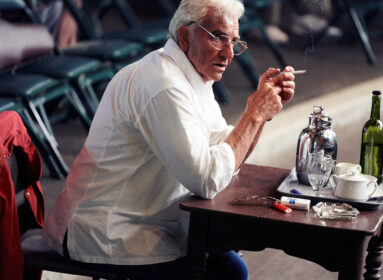“There is this myth that in the shtetl life was wonderful before the Nazis came and destroyed everything we had. The truth is that there was a virtual civil war among Jews before the war…”
By Cindy Mindell
In On the Eve, University of Chicago professor Bernard Wasserstein explores the final phase of European Jewish history before its near-total annihilation at the hands of the Nazis. The 2012 book, which received the Yad Vashem 2013 International Book Prize, was hailed by the selection committee as “a rare and excellent introduction, an evaluation that furnishes a deeper understanding of the events of the Holocaust.” The book is a rarity in a field rife with World War II-era accounts of Jewish life. In the same spirit, author Allan Chernoff creates a “communal memoir” of pre-war Jewish life in The Tailors of Tomaszow, just published by Texas Tech University Press.
Nearly 14,000 Jews, one-third of Tomaszow-Mazowiecki’s population, lived in the town in central Poland before World War II, many making their living as tailors and seamstresses. Only 250 of them survived the Holocaust, in part because of their skill with a needle and thread.
Chernoff co-wrote the book with his mother, Rena Margulies Chernoff, a native of the town and a Holocaust survivor. Among the first-hand accounts included in the book is that of Eva Tenenbaum Romanowitz, a first cousin of Rena Margulies Chernoff and mother of longtime Stamford resident Dr. Harry “Hesh” Romanowitz z”l, a renowned pediatrician and mohel who was active in the Jewish community and worked to keep Yiddish language and culture alive.
A veteran of national network TV news reporting, Allan Chernoff served as CNN’s senior correspondent and has reported for CNBC and NBC News programs. He is the recipient of six best reporting awards from the Society of Professional Journalists New York Chapter and was a reporter on teams winning Peabody and DuPont Awards.
Recently, he spoke with the Ledger about his latest work.
Q: How did the idea for The Tailors of Tomaszow evolve?
A: Growing up, I had a mutual protective conspiracy with my mother – she never talked about her Holocaust experiences and I never asked. She really started talking about it in 1980, when she attended a conference sponsored by the American Gathering of Holocaust Survivors in Washington, D.C.
This was not a book that I sat down and cranked out in 12 months. Much of the research I did decades ago, and most of the survivors I interviewed are no longer alive. I didn’t start out intending to write a book but I wanted to preserve the history of the town, collect information, and find out details about the town and life there before the war, as well as during and after the war. I was among the first volunteer interviewers for the Survivors of the Shoah Visual History Foundation [now USC Shoah Foundation Institute for Visual History and Education], and intentionally interviewed as many survivors as possible from Tomaszow. Part of our mission, as interviewers, was to find Holocaust survivors and reach out to them and, if they were willing, they would sit down to tell their stories. I found the Tomaszowers through a Tomaszow society and through relatives and friends.
Only after I had compiled a good amount of information did I start to say, “what can I make of this?” The more Shoah history and memoirs I read, I didn’t see anybody who had done a collective memoir and history of the survivors of one town. There are dozens of gripping stories but they are typically individual stories. There’s been great fiction, great histories and academic books, but I wanted to make something different. I felt an obligation to do something for Tomaszow so that the history is preserved.
Q: How did your mother become involved in the project?
A: A lot is told from my mom’s memory, but not all. She actually worked as a researcher and journalist with me on this project to get all the details. She would ask the questions of survivors, we went back to Tomaszow together and into the apartment where she grew up. We went to the library at Auschwitz and spent hours going through all the documentation and speaking with [the late] Danuta Czech, the senior librarian. My mother was able to determine precisely when she was on the transport to Auschwitz-Birkenau, who was on it with her, and other details of her experience because the Nazis kept very meticulous records.
Q: Were the the Yizker-bicher memorial books to the hundreds of Jewish communities decimated during the Holocaust part of your research?
A: The Tailors of Tomaszow contains excerpts from the Tomaszow Yizkor Book – eyewitness accounts of certain Nazi actions, when people were tortured or forced to throw their jewelry into a pile on a blanket in the center of town. There are descriptions of two separate deportations when Tomaszowers were sent for selection and most were placed onto trains to Treblinka, where the vast majority of the Tomaszow Jews were killed in the fall of 1943. Not every single tailor survived, but the book is called The Tailors of Tomaszow because many tailors were able to provide slave labor, and not only in the Blyzin camp. Before the press published my manuscript, they had it reviewed by several academic experts on the topic who said that this is the most detailed account of the camp. Slave labor occurred in Tomaszow itself. Workshops were established for shoemakers, metalworkers, and tailors. Workers would get a little piece of bread but at least it was something, and it helped many of the tailors avoid starvation.
Q: In the book’s introduction, your mother writes, “The Jews of Poland failed to unify, instead bickering among themselves” — an observation echoed in Bernard Wasserstein’s study of pre-war European Jewry. Did this manifest in Tomaszow?
A: There is this myth that in the shtetl, in the old country, life was wonderful before the Nazis came and destroyed everything we had. The truth is that there was a virtual civil war among Jews before the war – arguments about religion, secular vs. observant. There were arguments over language – Yiddish for the traditional Jews, Polish for the modernists. In my mother’s family, they spoke Polish; she didn’t learn Yiddish until she was in a DP camp in Germany, in order to communicate with friends from Russia. There were arguments about the future of the Jews and a communal response to antisemitism: the Bundists said, “we need to create a more just society here in Poland;” the Zionists said, “we need to get out, go to Palestine, and create our land there.” In the book, I give details of some of these meetings.
In one example, Eva Tenenbaum goes to a lecture by a leader of the Bund. Her father, a very traditionally observant Jew, finds out, goes to the meeting, takes her out, and for the only time in her life, beats her.
In another incident, Abe Romanowitz [who became Eva’s second husband, after the war], was the gabbai at the Groys Shul [main synagogue] in Tomaszow and would assign aliyahs to people who were not well off. That created a big furor. Someone came up to him and said, “Ve shayets [you’re an outlaw]; why do you give the big honor to poor people?”
Q: What was it like for your mother to finally tell her story in this way?
A: It was liberating for her. She grew up surrounded by other survivors but they were all the older generation. There were virtually no other survivors her age, except for her cousin Fryda. There were children who were hidden, Kindertransport survivors, but children who had actually gone through the ghetto, slave labor camp, death camps, and repeated selections – there was just a handful. So, in 1980, when she went to that conference – a place where she met and connected with other survivors from her generation – it was like a light was turned on for her. That opened her up and made her feel she wasn’t alone.
Q: Aside from opening a window on Jewish life in Poland before the Holocaust, what do you hope to accomplish with the book?
A: As the survivors pass – and most of the survivors I interviewed have passed – these histories become increasingly important, not only for preserving knowledge but also for the lessons they teach. We talk about the disagreements within the Jewish community at the time, which, frankly, made the Jews extremely vulnerable to the Nazi onslaught. Then I think about the divisions in Jewry today – religious, attitudes toward Israel, relationship with the Palestinians, and now the boycott, divestment, sanction controversy. Jews need to look in the mirror and need to look at their history; they need to read a book like this to gain some perspective on what they’re doing right now.
My particular intent is for this to be a resource for educators of all kinds. The book is the story of a town and I tell it through my mom’s voice, in part to make the story as accessible as possible to a broad audience – Jews, non-Jews, high-school students and older. The first third is all about the town, told largely through the eyes of a young girl and through her teenage neighbors and relatives. That gives a real intimate and detailed texture to the background and history. I take the reader inside the tailor shop and tell all the details that went behind the actual measuring and adjustments, my mom singing to customers, details of the changing room. You learn more than what happened during the Shoah; you learn about a lost world. It’s a well-researched history presented in a very non-academic fashion.
Allan Chernoff will discuss his new book on Sunday morning, Sept. 7 at Congregation Agudath Sholom, 301 Strawberry Hill Ave. The event is co-sponsored by several local Jewish organizations.
Comments? email cindym@jewishledger.com.







 Southern New England Jewish Ledger
Southern New England Jewish Ledger














